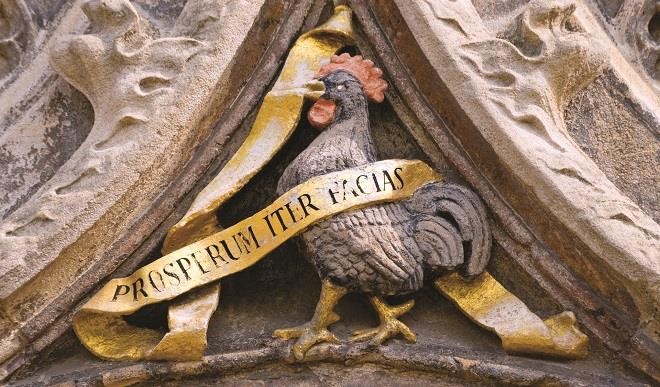‘The Cambridge cockerel is no Cecil Rhodes’ statue’
Students are calling for the cockerel of Jesus College, looted from Benin in 1897, to be returned to Africa. But it could still find an appropriate home in the UK. Students are right to be unhappy about the sculpture from Benin that stands in the hall of Jesus College, Cambridge. It should either be repatriated, […]


Students are calling for the cockerel of Jesus College, looted from Benin in 1897, to be returned to Africa. But it could still find an appropriate home in the UK.
Students are right to be unhappy about the sculpture from Benin that stands in the hall of Jesus College, Cambridge. It should either be repatriated, as students demand, or displayed in a totally different place and context.
The cockerel, or okukor, is a formidable sculpture: this proud and fierce bird is an embodiment of power, virility, and force. It is reminiscent of animal sculptures by Pablo Picasso – perhaps not surprisingly, since he was consciously influenced by African art.
In a demand that has been reported as echoing the campaign at Oxford University to bring down a statue of the Victorian imperialist Cecil Rhodes, the student union of Jesus College has voted to send this mighty creature home to Nigeria. “The request by students is being considered,” says the college.
Artistically, the cases of Cecil Rhodes are totally different. Personally, I think there’s a case for demolishing the Rhodes statue on aesthetic grounds alone. It’s an ugly, third-rate work that jars with its beautiful surroundings. The Jesus College cockerel, on the other hand, is an artistic masterpiece – and that is why the college must listen to what students are saying.
This is one of a huge haul of sculptures from the west African country of Benin seized as “reparations” by the British punitive expedition in 1897 that destroyed this kingdom. Benin had dared to defy the British empire at the height of its self-righteousness. Its ruler, the Oba, was demanding customs duties from British traders, and the dispute led to a group of British officials being killed. In retribution, Britain crushed one of Africa’s most brilliant cultures and treated its art as war spoils.
Today the magnificence of that art is recognised worldwide. At the British Museum in London, the history of Benin’s art can be explored in depth in a modern, thoughtful display – albeit composed largely of works taken in 1897 – that reveals its long history. Realistic art has been made in metal in this region of Africa since at least the middle ages. In the 14th and 15th centuries, heads of hypnotic perfection and beauty were cast in the gold-rich kingdom of Ife. The art of Benin took up that passion for metallurgy and eye for nature. Benin traded with Portuguese merchants in the Renaissance and its art was coveted in 16th- and 17th-century Europe: ivory salt cellars were made for the European market while the majestic, pungent metal plaques that once decorated the Oba’s palace include vivid portrayals of European soldiers and traders.
This rich artistic history was dismissed as a mere curiosity by the 19th-century raiders. Two ivory leopards were given to Queen Victoria as royal spoils. This was an age that refused to recognise the artistic achievements of “lesser breeds”.
The way Jesus College displays its cockerel is an archaic legacy of those unmourned times. This is a great work of art, but it is on view as a kind of heraldic mascot. What a patronising attitude. Jesus has three cockerels on its official crest, so this sculpture has been appropriated as a heraldic symbol. It is completely wrong for a work of art of this calibre to be trivialised like this, or displayed in a college hall with no sense of its context, history or aesthetic significance.
The cockerel belongs in a museum – but should that museum be in Nigeria or Britain? Here’s where I slightly disagree with the students. The modern state of Nigeria is not identical to the old kingdom of Benin. If this work should be repatriated anywhere, it is surely to Benin City itself, in southern Nigeria, where the artistic and religious traditions of Benin’s mighty art are still preserved and whose museum might provide a good home.
Yet there is also a case for works of art to tour around the world. The art of Benin is astounding; it is a great ambassador for Africa. The argument over ownership will never go away, but people who see the British Museum’s Benin masterpieces come away awestruck by Africa’s creative legacy.
What is not acceptable is trivialising and looking down on that legacy. Jesus College cannot continue to treat an African masterpiece as a quaint curio. It need not even leave Cambridge or cease being owned by the college. Why not simply give it a proper display at the city’s Fitzwilliam Museum? There it can take its place as the masterpiece it is. If Cambridge can’t do it that basic honour, then it really should go home to Benin City.
BENIN BRONZES: THE CELEBRATED ARTWORKS MIRED IN CONTROVERSY
The Benin Bronzes are a set of artworks created to celebrate the Benin Kingdom in what is modern-day Nigeria. Created by the Edo people in the 13th Century, many were looted from the area by British expeditions.
Today museums throughout Britain, Germany and the U.S. hold hundreds of the items – despite pleas from Nigeria for the artifacts to be returned.
When colonialists first discovered the pieces adorning the country’s royal palaces, they were amazed that such incredible artwork could be created by people so ‘primitive’.
Today they remain some of the most celebrated artworks to emerge from Africa, but much like Greece’s Elgin Marbles, they are mired in controversy due to the circumstances in which they were acquired.
Source: Theguardian.com
